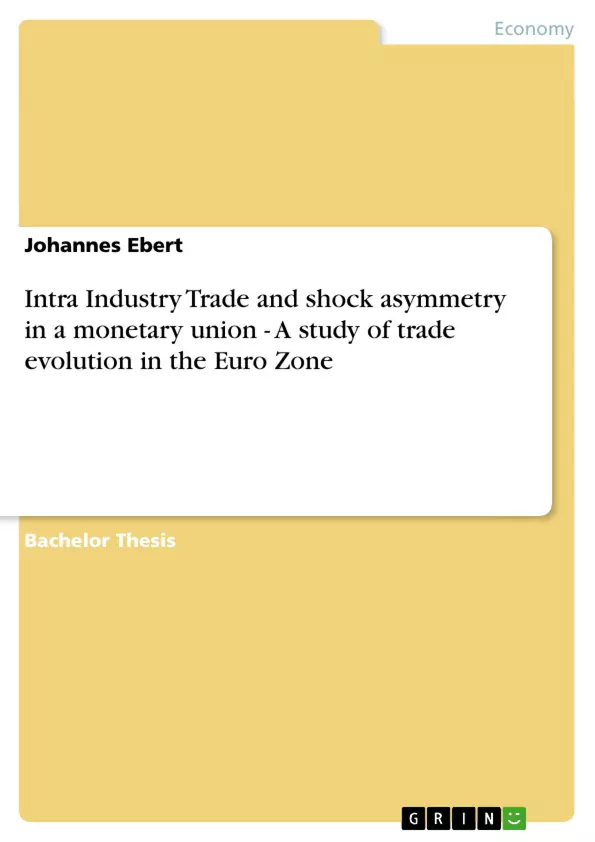Evolution of Intra-industry trade and OCA theory are closely linked via the correlation of Business Cycles and Kenen’s diversification criteria. Adapting a methodology from Fontagné and Freudenberg, I decompose trade patterns within the Euro zone for the period 1999-2011. The methodology allows for disentangling vertically and horizontally differentiated Intra-industry trade accounting for the different determinants of those two types of trade.
An increased specialization of countries in certain product categories cannot be confirmed,neither can an increase in Business cycle correlation as shares of the different trade types remain stable during the whole period of analysis.
Inhaltsverzeichnis (Table of Contents)
- Introduction
- Optimum Currency Area criteria
- The "classic" OCA theory
- Are OCA criteria endogenous?
- Intra-industry trade
- An interplay between theory and empirics
- Trade in vertically differentiated products - an ambiguous phenomenon
- Optimum Currency Areas and Intra-industry trade
- Trade pattern evolution endogeneity of OCA criteria - the ex ante view
- The ex post view
- Methodology
- The Data Source: COMEXT Database on european trade
- Decomposing trade flows
- Results
- Conclusion
Zielsetzung und Themenschwerpunkte (Objectives and Key Themes)
This study aims to analyze the evolution of intra-industry trade within the Eurozone between 1999 and 2011. The research investigates the relationship between intra-industry trade patterns and the theory of Optimum Currency Areas (OCA), focusing on the correlation of business cycles and Kenen's diversification criteria. The study employs a methodology adapted from Fontagné and Freudenberg to decompose trade patterns within the Eurozone, disentangling vertically and horizontally differentiated intra-industry trade. Key themes explored in the text include:- The relationship between intra-industry trade and OCA theory.
- The evolution of trade patterns within the Eurozone.
- The impact of vertically and horizontally differentiated intra-industry trade on business cycles.
- The endogeneity of OCA criteria and its impact on trade patterns.
- The application of a methodology to decompose trade flows and analyze different trade types.
Zusammenfassung der Kapitel (Chapter Summaries)
- Introduction: This chapter introduces the topic of the study, focusing on the relationship between intra-industry trade and OCA theory. It highlights the importance of understanding the evolution of trade patterns within the Eurozone and its implications for economic stability and growth.
- Optimum Currency Area criteria: This chapter examines the classical OCA theory and its criteria, specifically focusing on the correlation of business cycles and Kenen's diversification criteria. It discusses the implications of these criteria for the Eurozone and their potential impact on intra-industry trade.
- Intra-industry trade: This chapter provides a detailed overview of intra-industry trade, highlighting its different types and the theoretical frameworks used to analyze it. It discusses the interplay between theory and empirical evidence and explores the ambiguous nature of trade in vertically differentiated products.
- Optimum Currency Areas and Intra-industry trade: This chapter explores the relationship between OCA theory and intra-industry trade, examining the endogeneity of trade patterns and OCA criteria. It delves into the ex ante and ex post perspectives on the relationship between these two factors, exploring the implications for the Eurozone.
- Methodology: This chapter outlines the methodology used in the study, including the data source (COMEXT database on European trade) and the process of decomposing trade flows. It explains the methodology used to disentangle vertically and horizontally differentiated intra-industry trade, providing a detailed overview of the analytical framework.
Schlüsselwörter (Keywords)
This study explores the relationship between intra-industry trade and Optimum Currency Areas (OCA), focusing on the Eurozone. Key terms and concepts investigated include trade patterns, business cycles, Kenen's diversification criteria, vertically and horizontally differentiated intra-industry trade, methodology for trade flow decomposition, and the ex ante and ex post perspectives on the endogeneity of OCA criteria.- Citar trabajo
- Johannes Ebert (Autor), 2012, Intra Industry Trade and shock asymmetry in a monetary union - A study of trade evolution in the Euro Zone, Múnich, GRIN Verlag, https://www.grin.com/document/263926



